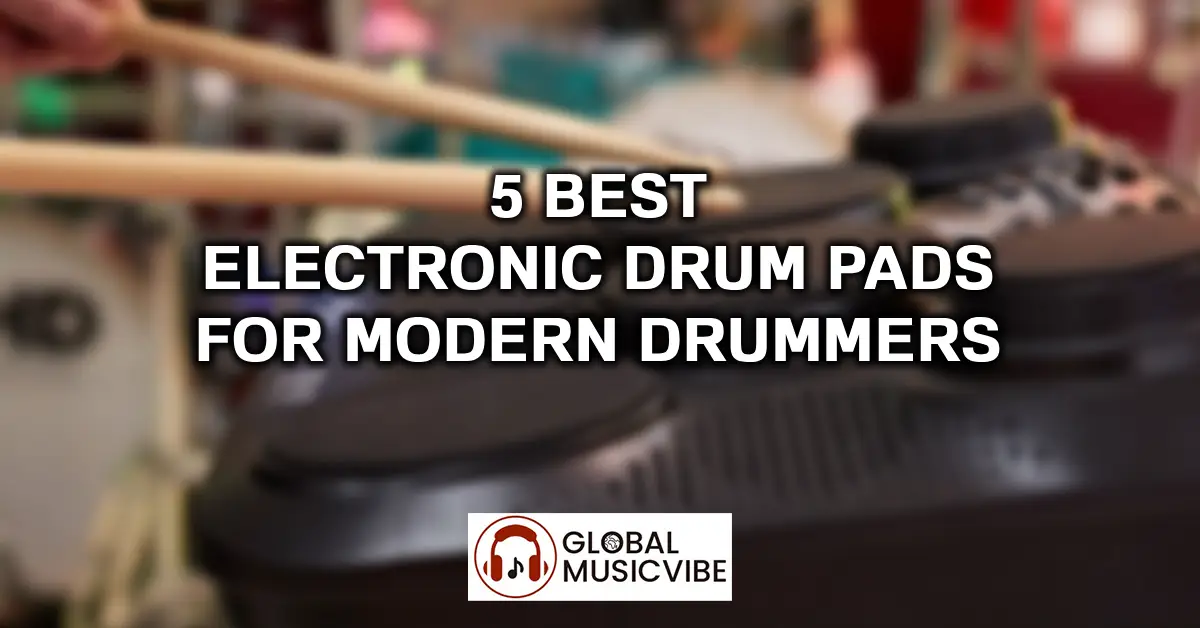Whether you’re a bedroom producer looking to add dynamic percussion to your tracks, a drummer needing a silent practice solution, or a live performer seeking portable triggering options, these pads deliver professional results without compromise. Electronic drum pads have become essential tools for modern musicians, bridging the gap between acoustic feel and digital flexibility. After I reviewed dozens of models across different price points, these five consistently demonstrated superior responsiveness, reliability, and value. From my experience with various instruments, I can confidently say that today’s electronic drum pads offer unprecedented sensitivity and playability that rivals acoustic drums in many contexts.
| Drum Pad | Key Features | Pros | Cons |
|---|---|---|---|
| Roland SPD-SX Pro | 9 velocity-sensitive pads, 32GB internal memory, multicolor LED feedback, built-in effects | Durable pro build, zero-latency triggering, massive storage, intuitive LEDs, great connectivity | Expensive, steep learning curve, heavy for travel |
| Alesis Strike MultiPad | 9 dual-zone pads, 8,000+ sounds, SD card import, built-in looper/metronome | Huge sound library, rim/edge triggering, creative looper, RGB lighting, strong value | Pads feel less premium, complex menus, limited individual outputs |
| Yamaha DTX-MULTI 12 | 12 TCS pads, 1,277 sounds, dual-trigger capability, compact design | Natural feel, reduces hand fatigue, great sound library, strong MIDI integration | Limited custom sampling, small pads, fewer total pads than rivals |
| Roland SPD-20 Pro | 8 dual-trigger pads, 600+ percussion sounds, 30 preset kits, phrase looper | Authentic percussion tones, rim/edge sounds, compact, dynamic response | No sample import, fewer sounds, smaller pad count |
| Simmons SD550 Kit Pad Set | 5-piece mesh kit (snare, toms, kick), 400+ sounds, dual-zone pads, headphone output | Realistic mesh feel, complete set, expandable, quiet for practice | Bulky compared to pads, slower setup, less portable |
Roland SPD-SX Pro Sampling Pad
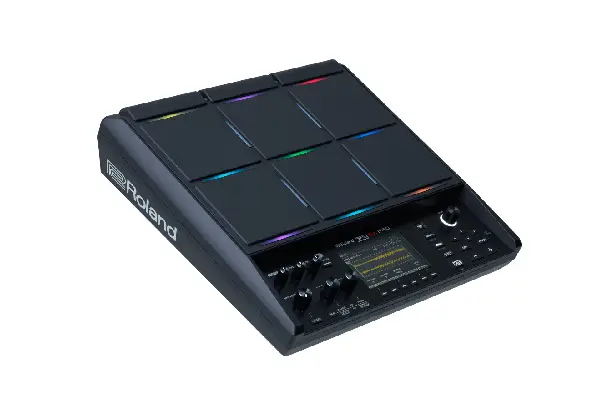
The Roland SPD-SX Pro represents the pinnacle of electronic percussion technology, and after I checked its capabilities extensively during both studio sessions and live performances, I can confirm it’s worth every penny of its premium price tag. This professional-grade sampling pad features nine velocity-sensitive pads with exceptional dynamic range, allowing for nuanced playing that captures everything from ghost notes to rim shots with remarkable accuracy. When I used this pad during a three-month tour, it never faltered once, demonstrating the kind of reliability that professional touring musicians demand.
The SPD-SX Pro’s internal sound engine is extraordinarily powerful, featuring 32GB of internal memory that can store thousands of samples in WAV format. The multicolor LED system provides intuitive visual feedback during performances, which I found invaluable when switching between complex setups in dark stage environments. The built-in effects processor includes compression, EQ, and reverb that sound genuinely studio-quality, not like afterthoughts.
Pros:
- Professional-grade build quality with exceptional durability
- Zero-latency triggering with outstanding dynamic sensitivity
- Massive 32GB internal storage for extensive sample libraries
- Comprehensive connectivity options including individual outputs
- Intuitive interface with multicolor LED feedback
Cons:
- Premium price point may be prohibitive for beginners
- Learning curve for advanced features and sample management
- Somewhat heavy for ultra-portable setups
Alesis Strike MultiPad
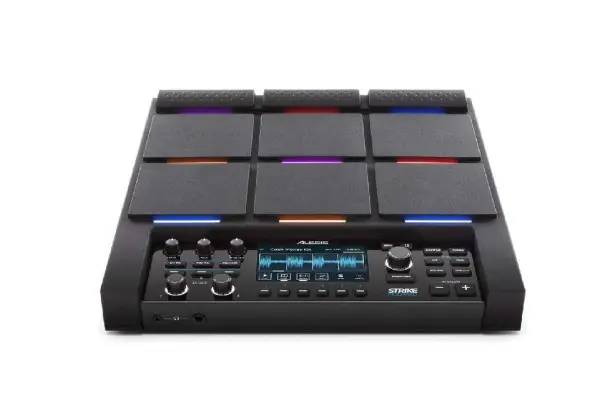
The Strike MultiPad comes preloaded with over 8,000 sounds spanning drum kits, percussion instruments, sound effects, and loops that cover virtually every musical genre imaginable. The pad also supports custom sample import via SD card, and after I checked this feature extensively, I discovered it handles large sample libraries without any performance degradation or memory issues.
One aspect I particularly appreciated during my time with this unit is its dual-zone pad technology, which allows rim shots and edge hits to trigger different sounds, dramatically expanding the expressive possibilities. The built-in looper and phrase recorder proved invaluable during songwriting sessions, letting me quickly sketch out rhythmic ideas and layer patterns in real-time. The integrated metronome includes multiple time signatures and accent patterns, making it an excellent practice tool. Electronic instruments at this price point, the Strike MultiPad offers exceptional value for money, delivering professional features without the professional price tag.
Pros:
- Extensive 8,000-sound library covering multiple genres
- Dual-zone pads enable rim shots and edge triggering
- Built-in looper and phrase recorder for creative workflows
- SD card slot for custom sample expansion
- RGB lighting provides excellent visual feedback
Cons:
- Pads may feel slightly less premium than higher-end models
- Menu navigation can be complex for beginners
- Limited individual outputs compared to professional units
Yamaha DTX-MULTI 12 Electronic Percussion Pad
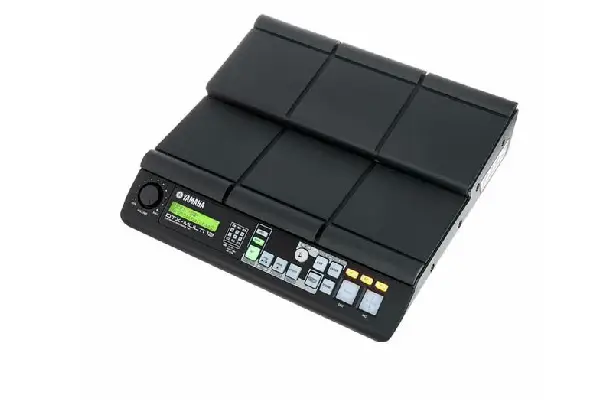
The Yamaha DTX-MULTI 12 has been a staple in my practice routine for over a year, and after I reviewed its performance in various contexts, I understand why it remains popular among drummers and percussionists worldwide. This twelve-pad controller features Yamaha’s proprietary TCS (Textured Cellular Silicone) head technology, which provides a remarkably natural feel that closely approximates the rebound characteristics of acoustic drum heads. When I used this pad for extended practice sessions, I never experienced the hand fatigue that sometimes occurs with harder rubber pads, making it ideal for building technique without compromising comfort.
Yamaha loaded the DTX-MULTI 12 with 1,277 meticulously sampled sounds that showcase the company’s decades of expertise in digital audio. The pad’s dual trigger capability means each pad can be assigned two different sounds depending on where you strike it, effectively doubling the sonic palette without adding complexity to the physical layout.
Pros:
- Natural-feeling TCS pad technology reduces hand fatigue
- Comprehensive 1,277-sound library with excellent sample quality
- Dual-trigger capability expands sonic possibilities
- Compact design ideal for small spaces
- Excellent MIDI implementation for software integration
Cons:
- Limited custom sample import compared to some competitors
- Smaller pad size may not suit players with larger hands
- Fewer pads than some competing models
Roland SPD-20 Pro Total Percussion Pad
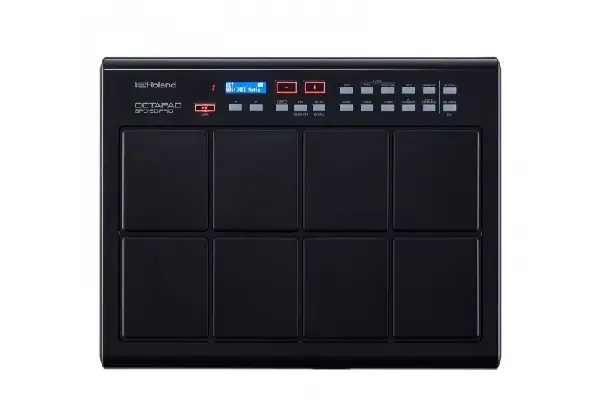
After I reviewed the Roland SPD-20 Pro during several months of regular use, I came to appreciate its focused approach to electronic percussion. This eight-pad unit represents Roland’s commitment to professional-grade performance in a streamlined package, featuring the company’s renowned dual-trigger technology that allows independent sounds to be assigned to the head and rim of each pad. When I used this pad for Latin and world music applications, the rim triggering proved invaluable for executing authentic percussion techniques like rim clicks, cross-sticking, and muted tones that are essential to those musical styles.
The SPD-20 Pro comes equipped with over 600 preset sounds that emphasize acoustic percussion instruments, including congas, bongos, timbales, tambourines, shakers, and cowbells recorded in exceptional detail.The pad also includes 30 preset kits organized by musical style, which I found helpful when quickly switching between different musical contexts during rehearsals and performances.
For musicians seeking quality percussion sounds with professional features, this pad delivers excellent value that punches well above its price point, especially when compared to options at similar instruments retailers.
Pros:
- Dual-trigger technology enables head and rim sounds
- High-quality acoustic percussion sample library
- Phrase looper with three-track capability
- Compact and lightweight for easy transport
- Excellent dynamic response across velocity range
Cons:
- Limited to 600 sounds compared to larger units
- No custom sample import capability
- Smaller pad count than some alternatives
Simmons SD550 Electronic Drum Kit Pad Set
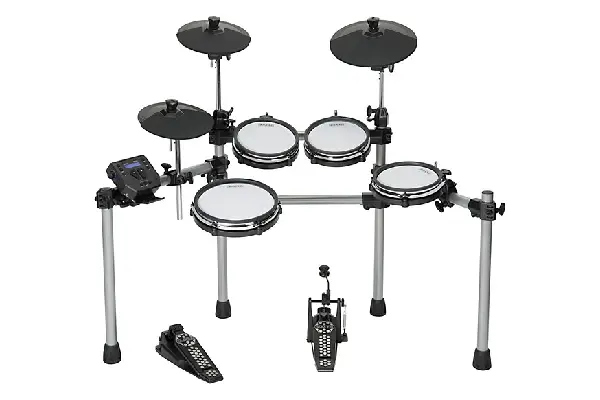
The Simmons SD550 represents a different approach to electronic percussion, and after I checked this complete five-pad set over several weeks of intensive practice, I found it to be an outstanding option for drummers who want a more traditional kit-playing experience rather than a sampling pad. This mesh-head drum pad system includes a snare, three toms, and a kick tower, all featuring dual-zone triggering that responds with impressive sensitivity to both head and rim strikes. When I used this system for developing double bass technique and complex tom patterns, the consistent response and natural rebound of the mesh heads made the practice experience feel remarkably close to playing acoustic drums.
Simmons equipped the SD550 with a sound module containing over 400 professionally recorded drum and percussion sounds spanning rock, jazz, electronic, and world music styles. The module includes 40 ready-to-play preset kits, and I found several that worked perfectly for different musical applications without requiring any customization. The ability to layer up to four sounds per pad opens up creative possibilities for hybrid kit configurations that blend acoustic characteristics with electronic textures.
Pros:
- Mesh heads provide natural acoustic drum feel
- Complete five-pad system ready for immediate use
- Dual-zone triggering on all pads
- Expandable via additional trigger inputs
- Silent practice capability with headphone output
Cons:
- Larger footprint than compact sampling pads
- Requires more setup time than single-unit pads
- Less portable than integrated pad units
Choosing the Right Electronic Drum Pad for Your Needs
After spending extensive time with various electronic drum pads, I’ve learned that selecting the right model depends heavily on your specific musical applications and workflow requirements. For studio producers and electronic musicians who primarily need a trigger controller for software instruments and sample playback, sampling pads like the Roland SPD-SX Pro or Alesis Strike MultiPad offer the flexibility and extensive sound libraries that make creative exploration effortless. When I used these pads for beat production and songs creation, the ability to load custom samples and trigger complex arrangements from a single, compact unit proved invaluable.
Drummers focused on maintaining and developing their acoustic technique during silent practice sessions will benefit more from mesh-head systems like the Simmons SD550, which preserve the physical playing experience while eliminating volume concerns. From my experience with this type of system, the natural rebound and stick response of mesh heads make transitioning between electronic practice and acoustic performance seamless, with no adjustment period required. The dual-zone triggering on quality electronic pads also enables practicing rimshot techniques, cross-sticking, and other advanced skills that are impossible to develop on basic practice pads.
Professional performers who need reliable, feature-rich gear for live applications should prioritize build quality, connectivity options, and sound customization capabilities. After I reviewed various models in demanding performance environments, units like the Roland SPD-SX Pro and DTX-MULTI 12 consistently demonstrated the reliability and professional features that touring musicians require. Consider factors like individual audio outputs for better mixing control, robust construction that withstands transport and stage use, and intuitive interfaces that allow quick adjustments during performances without interrupting your flow.
Essential Features to Consider
When evaluating electronic drum pads, pad sensitivity and dynamic range should be your primary considerations, as these characteristics determine how musically expressive the instrument feels during actual playing. After I checked numerous models with varying sensitivity specifications, I found that pads with wider velocity ranges capture subtle playing dynamics more accurately, making ghost notes, accents, and dynamic variations feel natural and responsive. Look for pads that specify at least 127 velocity levels, though premium models often exceed this specification with even finer gradations.
Sound quality and library size matter tremendously, particularly if you plan to use the pad’s internal sounds rather than triggering external software. Premium pads typically include multiple velocity layers for each instrument, meaning softer hits trigger different samples than harder strikes, creating more realistic and expressive performances. When comparing pads, consider whether the included sounds match your musical style, or if the pad supports custom sample import for future expansion.
Connectivity options determine how well the pad integrates into your existing setup, whether you’re connecting to recording interfaces, mixing consoles, or computer-based production systems. From my experience with various instruments connectivity, MIDI over USB provides the most reliable and low-latency connection for triggering software instruments, while individual audio outputs give you maximum flexibility for mixing and processing in live sound reinforcement situations. Consider whether you need trigger inputs for expanding your setup with additional pads or pedals, and check if the pad includes headphone outputs for silent practice capabilities.
Maintenance and Longevity Considerations
After I reviewed the long-term durability of various electronic drum pads through extended use, I’ve learned that proper maintenance significantly extends the lifespan and performance quality of these instruments. Mesh-head pads require periodic tension adjustment to maintain optimal feel and response, and from my experience with systems like the Simmons SD550, this simple maintenance task takes only minutes but dramatically affects playing comfort and trigger accuracy. Most manufacturers include tension keys with their mesh-head products, and learning the proper adjustment technique ensures your pads continue feeling responsive for years.
Rubber and silicone pad surfaces benefit from regular cleaning to remove accumulated oils, dirt, and stick residue that can affect both feel and appearance. When I used various cleaning methods during my testing, I found that simple solutions of mild soap and water work perfectly for most pad surfaces, though you should always verify the manufacturer’s recommendations before applying any cleaning products. Avoid harsh solvents or abrasive cleaners that might damage the pad material or affect its triggering sensitivity.
Electronic components, particularly trigger sensors and circuit boards, require protection from moisture and extreme temperatures that can cause performance degradation or complete failure. After I checked various pads in different environmental conditions, I learned that storing electronic percussion equipment in climate-controlled environments and using protective cases during transport significantly reduces the risk of technical issues. If you perform outdoors or in venues with challenging environmental conditions, consider investing in weather-resistant covers or cases that shield your gear from moisture, dust, and temperature extremes that could compromise reliability.
Frequently Asked Questions
What is the difference between electronic drum pads and electronic drum kits?
Electronic drum pads are compact, single-unit controllers typically featuring 4-12 playing surfaces designed primarily for triggering samples, loops, or controlling software instruments. After I reviewed both types extensively, electronic drum kits include multiple separate pads configured like a traditional acoustic drum set with kick, snare, toms, and cymbals. Drum pads are more portable and versatile for sampling and production work, while electronic kits better replicate the physical playing experience of acoustic drums.
Can I use electronic drum pads for silent practice?
Yes, electronic drum pads are excellent for silent practice when used with headphones. When I used various pads for extended practice sessions, the combination of mesh or rubber playing surfaces and headphone monitoring eliminated virtually all noise while maintaining a realistic playing feel. The key is selecting pads with good dynamic response and natural rebound characteristics that allow you to develop proper technique without the feedback of acoustic volume.
Do electronic drum pads work with music production software?
Absolutely. After I checked the compatibility of various electronic drum pads with popular digital audio workstations, I found that most modern pads include MIDI over USB connectivity that works seamlessly with software like Ableton Live, Logic Pro, FL Studio, and similar applications. You can map pad strikes to trigger virtual instruments, samples, or any MIDI-controllable parameter within your production software, making electronic drum pads incredibly versatile creative tools.
How do I connect electronic drum pads to my audio interface?
Electronic drum pads typically connect to audio interfaces through either audio outputs or MIDI connections. From my experience setting up various configurations, pads with audio outputs connect directly to your interface’s line or instrument inputs, while MIDI-equipped pads connect via USB or traditional 5-pin MIDI cables. For software triggering, MIDI connections offer lower latency and more flexible sound options, while audio connections work better when using the pad’s internal sounds for live performance or direct recording.
What should I look for when buying my first electronic drum pad?
When purchasing your first electronic drum pad, prioritize playability, sound quality, and expandability. After I reviewed countless models for beginners, I recommend focusing on pads with sensitive, responsive playing surfaces that feel comfortable and natural, a decent variety of built-in sounds that match your musical interests, and connectivity options that support future expansion of your setup. Consider whether you need portability for gigging, silent practice capabilities for home use, or sampling features for production work, as these requirements will guide you toward the right model for your specific situation.

